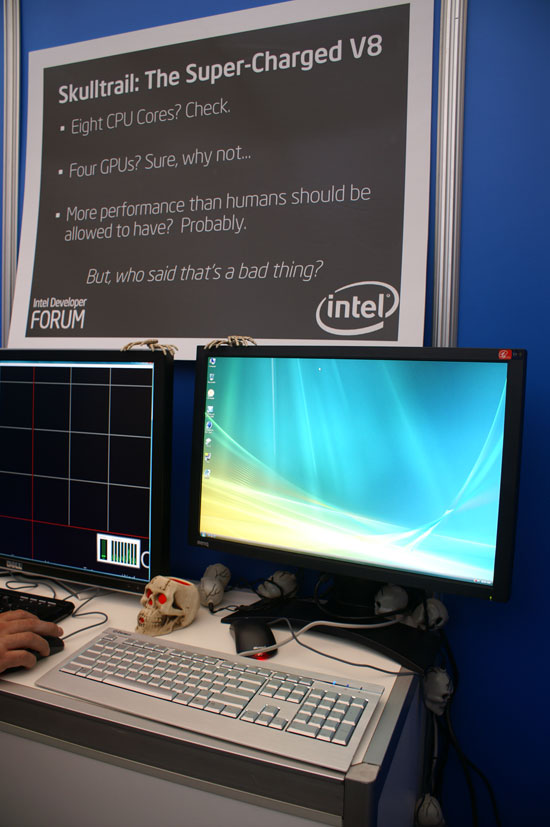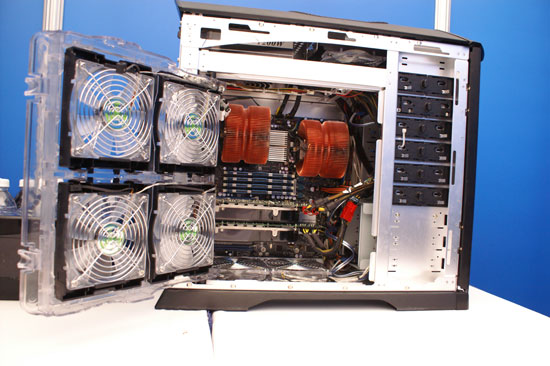Penryn and SkullTrail Benchmarked at IDF
by Anand Shimpi & Cara Hamm on September 20, 2007 3:00 PM EST- Posted in
- CPUs
Intel's 8-core SkullTrail System
Intel also had its SkullTrail system up, running, and ready to be benchmarked. SkullTrail features two LGA-771 sockets, accepting a pair of special unlocked Penryn processors that use the Xeon socket but have the same core as the desktop processors. According to Intel, with the Core 2 based processors there are slight differences in the hardware prefetchers in Xeon vs. desktop Core 2 parts and thus it is important to distinguish the SkullTrail CPUs as being Yorkfield based (desktop Penryn) and not Harpertown (server Penryn).

The SkullTrail motherboard actually supports NVIDIA's SLI, which is apparently made possible by actually using a pair of NVIDIA MCPs on the motherboard itself. This isn't an SLI licensing deal; this is Intel purchasing NVIDIA MCPs and using them on its motherboard. 2-way SLI is supported today and Intel claims eventual support for up to 4-GPU SLI, depending on whenever NVIDIA releases drivers and product.

The memory technology is still FB-DIMM unfortunately, but the speeds have been bumped from V8 to DDR2-800 now. The motherboard also offers support for a 1600MHz FSB, and the CPUs installed ran at 3.40GHz (quad-core, 12MB L2, two physical chips).

With a total of eight cores there aren't that many desktop benchmarks you can run and actually get good scaling, but Intel managed to pick some that did. The comparison system is a single-socket, quad-core Yorkfield/Penryn on an Intel X38 motherboard running at 3.0GHz/1333MHz FSB. The other key system difference is that the Yorkfield system only has a single GeForce 8800 GTX while the SkullTrail system has two, because it can support them. Intel also outfitted the Yorkfield with 2GB of memory while the SkullTrail had 4GB of memory; while the SkullTrail system should be faster regardless, it wasn't a fair fight from the get-go.

Oh look, Skulls, clever.
| Desktop System Configuration | ||
| SkullTrail System | Yorkfield System | |
| CPU | 2 x quad-core 3.4GHz 1600MHz FSB, 12MB L2 |
1 x quad-core 3.0GHz 1333MHz FSB, 12MB L2 |
| Motherboard | SkullTrail dual socket | Intel X38 |
| Graphics | 2 x GeForce 8800 GTX | 1 x GeForce 8800 GTX |
| Graphics Driver | NVIDIA pre-production driver | NVIDIA 162.22 |
| Memory | 2 x 2GB Micron DDR2-800 CL5 FB-DIMMs |
2 x 1GB Corsair CM3X1024-1333C9DHX |
| Hard Drive | Seagate Barracuda 320GB 7200.10 7200RPM |
Seagate Barracuda 320GB 7200.10 7200RPM |
| OS | Windows Vista Ultimate 32-bit | Windows Vista Ultimate 32-bit |
While we will report the 3DMark '06 numbers we ran during our time with the system, it's not entirely a CPU comparison given the dramatic difference in GPU configurations. However, the CPU tests within 3DMark do generally place the majority of the load on the CPU, while the 3D results (which we're not reporting) heavily stress the GPU(s). However, Cinebench and TMPGEnc show pure CPU-crunching 4-to-8 core CPU scaling.
| Desktop Performance Results | ||
| SkullTrail System | Penryn System | |
| 3DMark 06 V1.1.0 Pro - CPU (score, higher is better) |
6359 | 4569 |
| 3DMark 06 V1.1.0 Pro - Overall (score, higher is better) |
17006 | 11899 |
| Cinebench R10 Beta (CPU benchmark, higher is better) |
21672 | 11810 |
| TMPGEnc 4.0 Express 4.3.3.9999 Beta (seconds, lower is better) |
53 | 72 |
Cinebench R10 performance virtually doubles, while there's a 26% reduction in encoding time in TMPGEnc. If you have the applications to take advantage of it, SkullTrail will give you 8 cores today instead of waiting until sometime in 2008/2009 for octal-core Nehalem.

We're not particularly sold on SkullTrail or any of these enthusiast-class dual socket systems (e.g. QuadFX, Intel V8), the performance is there but we're not sure the usage models are. They may be perfect for workstation users who also want to game on their machines, but other than that specific market we don't see much of a need for even the most demanding enthusiasts. Stressing four cores is tough enough most of the time, making the argument for eight at the sacrifice of price, power and noise is a difficult one.

Another skull, clever-er










15 Comments
View All Comments
Beenthere - Wednesday, September 26, 2007 - link
Intel keeps releasing engineering samples and tech info. to the media because they are running scared. AMD is once again delivering the best of breed and Intel is in for one Helleva beating to come now that Barcelona is available and ramping in clockspeed. The shitze is about to hit the fan!Zak - Monday, September 24, 2007 - link
I've just built a new gaming rig last week: the new 3GHz Core2Duo (@3.8GHz with Tuniq cooler) and 8800GTX (slightly o/clocked) with 3GB of 800MHZ RAM, 600W PS, the whole thing sans case and HD, which I already had, was just under $1,200 and I get over 12000 points in 3DMark and 100% stable with few 12cm fans and CM Stacker case. So with a decent case and a couple of HDs it'd be around $1,500. I can imagine I can build a system for $3000 that will get close to 17000 points. WTF?There is no reason to even consider this monstrosity unless you have a really small penis...
Z.
Amiteriver - Sunday, September 23, 2007 - link
Ran a quick FM06 at 3467 (13x)on a qx6700 with 2 GTX SLI and got 17,425 pts overall with nothing tweeked. G Kind of thinking in this bench mark - wheres the beef.vgermax - Thursday, September 20, 2007 - link
Why are the TMPGEnc scores listed as 151 and 239 for both comparisons? It seems a might coincidence if a different encoded file would result in identical scores in comparing Penryn/Merom and Skulltrail/Penryn. Either that or the mobile Penryn is as fast as Skulltrail, with the desktop Penryn being the same speed as Merom, which doesn't seem plausible.tayhimself - Thursday, September 20, 2007 - link
What the f**k???????????///////slashsmilingcrow - Thursday, September 20, 2007 - link
“TMPGEnc 4.0 Express Beta (seconds)151 239
while there's a 26% reduction in encoding time in TMPGEnc.”
The reduction is 88 seconds which equates to a ~37% reduction, or you could say that the single CPU system takes ~58% longer.
joex444 - Thursday, September 20, 2007 - link
Yea, they suck.mcnabney - Thursday, September 20, 2007 - link
About a 40% increase in gaming performance by adding a second top-end video card and doubling the number of CPUs that also happen to run at a higher speed. A good bit better, yes, but the performance hardly scales with the amount of hardware.retrospooty - Thursday, September 20, 2007 - link
Its not really a gaming system. There games are now being coded to use 2 cores, and a few that do 4 cores, but nothing uses 8. 8 is for special use niche apps at this point.mcnabney - Thursday, September 20, 2007 - link
Yes, they cleverly disguised a plainjane workstation by covering it with skulls and loading two $700 gaming video cards into it...